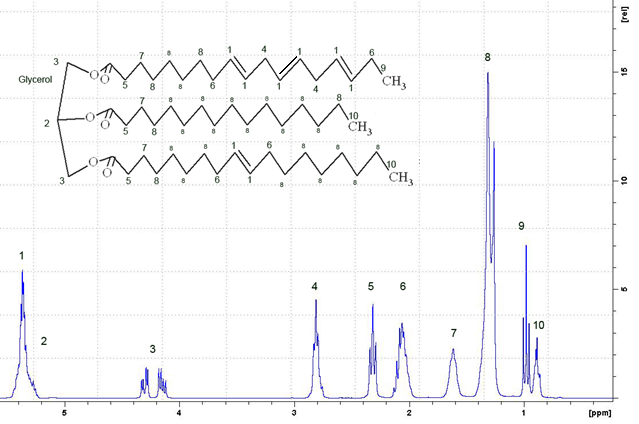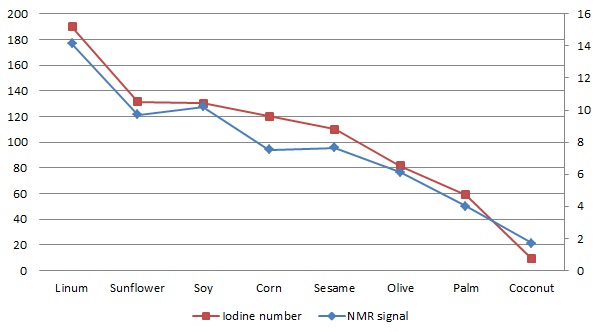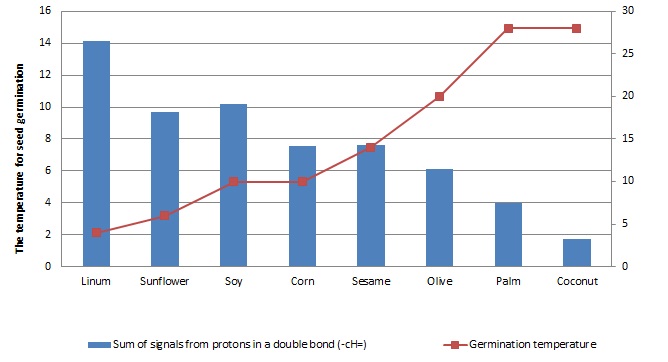Abstract
The article deals with the use of the method of nuclear magnetic resonance spectroscopy to study the composition of vegetable fats. It has shown its effectiveness in biological research not only of pure substances, but also of mixtures of biologically active substances, such as biological fluids: blood plasma, gland tears, sweat, fat. Vegetable oils have long been used by humans. In the twentieth century, interest in them increased again due to a change in the economic vector in the production and consumption of vegetable fats. There has been an increase in the use of palm oil, displacing a number of other fats of both vegetable and animal origin. Vegetable oils contain different types of fatty acids. Of these, the group of polyunsaturated acids is an irreplaceable component of food, since it is not synthesized by the human body. The usefulness of this or that plant product depends on which fatty acids are the structural components of its oils. Comparison of the data of nuclear magnetic resonance spectroscopy, obtained as a result of the study with the iodine numbers of the studied oils, revealed a complete correspondence of the compared indicators. The described method allows to determine with high accuracy the relative content of double bonds in the composition of fatty acids, to determine the relative content of polyunsaturated fatty acids and ω-3 fatty acids.
Keywords: Vegetable oil, nuclear magnetic resonance spectroscopy, polyunsaturated fatty acids
Introduction
Fats are a group of organic compounds that play an important role in the life of living organisms. Fats form the basis of all membrane structures of a living cell. They are quite easily broken down and used to meet the energy needs of the body. It is known that the breakdown of a fat molecule provides more energy than the breakdown of a carbohydrate or protein molecule almost twice. Fats are a source of metabolic water, a number of fat-soluble vitamins (A, D, E, K). Fatty acids form acetyl-CoA, which is involved in glycolysis. The fat (lipid) molecule consists of glycerol and fatty acid residues. Fatty acids are divided into saturated, monounsaturated, and polyunsaturated. It is the group of polyunsaturated acids that is an irreplaceable component of food, since it is not synthesized by the human body (Titov et al., 2017; Vlasova et al., 2016; Vlasova et al., 2019). Polyunsaturated fatty acids are essential for the synthesis of many vital substances in the human body. A lack of these fatty acids in the diet can be the cause of a number of diseases.
The main part of the necessary types of fats comes into the body with food of plant and animal origin, and the primary diversity is provided by plant food, which contains the polyunsaturated types of fatty acids so necessary for the body. However, different types of plants contain different amounts of types of fatty acids, different combinations. Thus, the usefulness of one or another plant product cannot be the same (Cazzola et al., 2017) For example, palm oil contains mainly saturated fatty acids (palmitic and stearic), and practically does not contain useful types of fatty acids from the group of polyunsaturated (Khodenkov & Bukatenko, 2014; Zolochevsky, 2011). Heat-loving plants do not contain the required amount of polyunsaturated fatty acids, and in order to replenish them in the body, it is necessary to eat more fish and meat. When eating plants growing in areas with negative temperatures, this need decreases.
Problem Statement
The study of the composition of lipids in consumed foodstuffs allows to determine the degree of their usefulness, and, accordingly, the dosage of consumption. A group of methods has been developed to determine the chemical and physical parameters of fats. One of the most promising for application can be the method of nuclear magnetic resonance for studying the structure of vegetable oils.
Research Questions
The classical methods for the analysis of vegetable fats are chromatography, as well as the determination of chemical and physical parameters, such as melting point, refractive indices, iodine number and other indicators (Schuler et al., 2016). Nuclear magnetic resonance (NMR) spectroscopy is one of the new methods for studying oils. NMR has shown its effectiveness in biological studies of not only pure substances, but also mixtures of biologically active substances, such as biological fluids: sweat, tears, blood plasma, fat (Drozdov, 2013).
Purpose of the Study
The aim of the work was to assess the possibility of using the method of nuclear magnetic resonance in the study of the structure of vegetable oils, the possibility of revealing the fundamental differences in the biochemical composition of different types of oils of different plant crops.
Research Methods
The classical methods for the analysis of vegetable fats are chromatography, as well as the determination of chemical and physical parameters, such as melting point, refractive indices, iodine number and other indicators (Schuler et al., 2016). Nuclear magnetic resonance (NMR) spectroscopy is one of the new methods for studying oils. NMR has shown its effectiveness in biological studies of not only pure substances, but also mixtures of biologically active substances, such as biological fluids: sweat, tears, blood plasma, fat (Drozdov, 2013).
For the study, plant oils were taken (flax, sunflower, soy, corn, sesame, olive, oil palm, coconut). Plants from different climatic zones, temperate, subtropical and tropical, were selected for the study.
To obtain the proton spectrum of the oil, we used a Bruker spectrometer (Germany) with a proton resonance frequency of 300 MHz. To obtain spectra, the studied oil was mixed with deuterated chloroform in a 1: 5 ratio (Alexandri et al., 2017).
Methyl esters of fatty acids (FA) were obtained by the method of Carreau and Dubacq (1978). The FA methyl esters were purified by column chromatography on silica gel in a hexane: diethyl ether solvent system (98: 2 by volume) (Kates, 1973). Analysis of fatty acid methyl esters was carried out on a Shimadzu GC-2010 plus gas chromatograph with a flame ionization detector and a Supelcowax-10 capillary column (length 30 mm, inner diameter 0.25 mm, phase thickness 0.25 μm; injector temperature 250 ° C, columns - 200 ° C, detector - 270 ° C); helium with a linear flow rate of 40 cm / s was used as a carrier gas. Fatty acids were identified using standards and equivalent chain lengths (Stransky et al., 1997).
Findings
To obtain the proton spectrum of the oil, a DRX-5 spectrometer (Bruker) with a resonance frequency of 300 MHz at a temperature of 26 ° C was used. To automatically adjust the uniformity of the magnetic field along the deuterium channel, the oils were dissolved in deuterated chloroform (CDCl3); the signal from TMS (C4H12Si) served as a standard. The data obtained from proton 1-D spectroscopy represent on the ordinate the signal intensity from protons in various chemical bonds and states. This, in turn, provides information on the proportional content of nuclei in various chemical states in the sample under study. The chemical shift value is expressed in parts per million of the base frequency or ppm (parts per million). Using the spectrometer, integrals of NMR signals from two regions were obtained - 0-6 ppm and 5-6 ppm. The value of the first was equated to 100%, as the total signal from all triglycerides in the oil, then an integral was obtained (Figure 01). The integral in the range of 5-6 ppm includes the signal from one hydrogen in glycerol and the signals from all the hydrogen in the double bonds of fatty acids. This value characterizes the unsaturation of fatty acid radicals that make up the oil.

Comparison of the NMR data with the iodine numbers of the studied oils revealed a complete correspondence of the compared indicators (Figure 02).
The iodine number is the number of grams of iodine required to saturate the unsaturated fatty acids in 100 grams of fat. The more unsaturated fatty acids contained in fat, the higher the iodine value. The iodine number is one of the most important indicators for oils (fats). It allows you to judge the degree of saturation of the oil (fat), its tendency to dry out, rancid and other changes occurring during the storage and processing of edible and industrial oils. A decrease in the iodine number during storage of oil is an indicator of its deterioration (Guzikov et al., 2007).
It is known that oils containing more polyunsaturated fatty acids have a lower pour point. So the pour point of linseed oil ranges from - 16 to - 28 ° C, and palm oil from +31 to +41 ° C. Moreover, the lower the seed germination temperature (Figure 03), the greater the number of double bonds in the oil of these plants.


It is obvious that the percentage of double bonds in oil is an adaptive mechanism to environmental conditions. The oils in the grains provide energy for plant germination and growth. Plants growing in cold climates store more unsaturated fatty acids, which allows them to germinate at lower temperatures and gain an advantage over other plants. The oils of plants growing in warm latitudes are characterized by a lower content of unsaturated fatty acids. This allows the seeds not to go rancid for a long time even at high positive temperatures.
Polyunsaturated fatty acids (PUFAs) are essential for the synthesis of many vital substances in the human body. A lack of these fatty acids in the diet can lead to visual impairment, dry skin, and impairment of skeletal muscle contractility. The lack of PUFA in the nutrition of pregnant women leads to a slowdown in fetal growth, impaired myelination of the pathways of the child's brain. Earlier, the more frequent detection of these diseases in residents of southern countries was associated with the fact that their diet is poorer (Stonik, 2018), but based on the data obtained, it can be concluded that the reason is different. Heat-loving plants do not contain the required amount of polyunsaturated fatty acids and to replenish them in the body, it is necessary to eat more fish and meat. When eating plants growing in areas with negative temperatures, this need decreases. So the content of polyunsaturated fatty acids in flaxseed oil is comparable to fish oil of some fish species.
Conclusion
The results obtained show that the NMR method allows one to obtain accurate characteristics of vegetable oils, to determine with high accuracy the relative content of double bonds in the composition of fatty acids. This method can be used to determine the relative content of polyunsaturated fatty acids and ω-3 fatty acids.
References
Alexandri, E., Ahmed, R., Siddiqui, H., Choudhary, M. I., Tsiafoulis, C. G., & Gerothanassis, I. P. (2017). High resolution NMR spectroscopy as a structural and analytical tool for unsaturated lipids in solution. Molecules, 22(10), 1663. DOI:
Carreau, J. P., & Dubacq, J. P. (1978). Adaptation of a macro-scale method to the micro-scale for fatty acid methyl transesterification of biological lipid extracts. J. Chroma-togr, 151(3), 384-390.
Cazzola, R., Benvenuto, C., & Porta, M. (2017). Palm oil: health risks and benefits. Agro FOOD Industry Hi Tech, 28(6), 57-59.
Drozdov, K. A. (2013). Primeneniye magnitno-rezonansnoy tomografii i spektroskopii dlya kharakteristiki funktsional'nykh i metabolicheskikh izmeneniy mozga v ranniy vosstanovitel'nyy postkommotsionnyy period [Application of magnetic resonance imaging and spectroscopy to characterize functional and metabolic changes in the brain in the early recovery post-concussion period]. Saint Peterburg: Institut fiziologii im. I.P. Pavlova. [in Russ.].
Guzikov, A. Ya., Makaseyeva, O. N., & Tkachenko, L. M. (2007). Khimiya i biokhimiya lipidov [Chemistry and biochemistry of lipids]. Mogilev State University of Food. [in Russ.].
Kates, M. (1973). Techniques of lipidology. Isolation, analysis and identification of lipids. Elevier.
Khodenkov, A. E., & Bukatenko, N. A. (2014). Vliyaniye pal'movogo masla na organizm cheloveka. [The influence of palm oil on the human body]. Proceedings of Human security in modern conditions conference, 327-329. [in Russ.].
Schuler, A., Pereira, F., Lima, V., Carvalho, S., & Sobral, A. (2016). Chromatographic Characterization of Potential Feedstocks for Biodiesel Production. CSIJ, 17(2), 1-10, 29458.
Stonik, V. A. (2018). Biomolekuly [Biomolecules]. Dalizdat. [in Russ.].
Stransky, K., Jursik, T., & Vitek, A. (1997). Standard equivalent chain length values of monoenic and polyenic fatty acids. Journal of High Resolution Chromatography, 20(3), 143-158. DOI:
Titov, V. N., Amelyushkina, V. A., Aripovskiy, A. V., Tibilova, O. A., Kaba, S. I., & Kukharchuk, V. V. (2017). Fiziko-khimicheskiye i biologicheskiye svoystva triglitseridov; pogloshcheniye kletkami funktsional'no raznykh pal'mitinovykh + oleinovykh lipoproteidov ochen' nizkoy i linolenovykh + linolenovykh lipoproteidov nizkoy plotnosti [Physical, chemical and biological properties of triglycerides; uptake by cells of functionally different palmitic + oleic very low lipoproteins and linolenic + linolenic low density lipoproteins]. Clinical laboratory diagnostics, 62(10), 580-592. http//doi.org/10.18821/0869-2084-2017-62-10-580-592. [in Russ.].
Vlasova, O. S., Tret'yakova, T. V., Bichkayeva, F. A., & Baranova, N. F. (2019). Assotsiatsii polinenasyshchennykh zhirnykh kislot i parametrov uglevodnogo obmena u devushek severnykh regionov [Associations of polyunsaturated fatty acids and parameters of carbohydrate metabolism in girls from northern regions]. Human Ecology, 6, 51-58. [in Russ.].
Vlasova, O. S., Bichkayeva, F. A., & Tret'yakova, T. V. (2016). Rol' zhirnykh kislot, vodorastvorimykh vitaminov, kal'tsiya, fosfora v obespechenii uglevodnogo obmena u yunosheskogo naseleniya dvukh raznykh klimatogeograficheskikh regionov [The role of fatty acids, water-soluble vitamins, calcium, phosphorus in providing carbohydrate metabolism in the adolescent population of two different climatic and geographical regions]. Clinical laboratory diagnostics, 61(4), 204-209. DOI: 10.18821/0869-2084-2016-61-4-204-209 [in Russ.].
Zolochevsky, V. T. (2011). Standart na pal'movoye maslo: za i protiv [Palm oil standard: pros and cons]. Oils and fat, 7, 22-24. [in Russ.].
Copyright information

This work is licensed under a Creative Commons Attribution-NonCommercial-NoDerivatives 4.0 International License.
About this article
Publication Date
21 June 2021
Article Doi
eBook ISBN
978-1-80296-110-2
Publisher
European Publisher
Volume
111
Print ISBN (optional)
-
Edition Number
1st Edition
Pages
1-1168
Subjects
Social sciences, education and psychology, technology and education, economics and law, interdisciplinary sciences
Cite this article as:
Drozdov, K. A., Makarenko, V. P., & Vshivkova, T. S. (2021). Method Of Nuclear Magnetic Resonance Spectroscopy For Studying Vegetable Fats Composition. In N. G. Bogachenko (Ed.), Amurcon 2020: International Scientific Conference, vol 111. European Proceedings of Social and Behavioural Sciences (pp. 612-618). European Publisher. https://doi.org/10.15405/epsbs.2021.06.03.82

